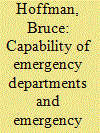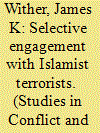| Srl | Item |
| 1 |
ID:
087387


|
|
|
|
|
| Publication |
2009.
|
| Summary/Abstract |
Despite the potential array of atypical medical contingencies that the U.S. health system could face if confronted with mass-casualty events (MCE) resulting from terrorist attacks using conventional explosives, American hospitals are neither sufficiently funded nor prepared to effectively respond to such potentialities. Historically, the bias in most MCE planning has been toward the worst case scenarios, often entailing weapons of mass destruction (such as chemical, biological, radiological, and nuclear weapons), on the assumption that any other MCEs, including those where conventional explosions are used, can simply be addressed as a lesser-included contingency. Yet, MCEs present unique medical challenges that to date the United States has mercifully rarely experienced but nonetheless must be prepared for.
|
|
|
|
|
|
|
|
|
|
|
|
|
|
|
|
| 2 |
ID:
087383


|
|
|
|
|
| Publication |
2009.
|
| Summary/Abstract |
Over the last few years, much attention has been devoted to the phenomenon of homegrown jihadist networks in the West. Most analyses have been based on the dual assumption that this phenomenon has manifested itself only extremely recently and that it is largely limited to Europe. While these two assertions are not completely unfounded, they do not take into consideration significant anecdotal evidence pointing to a long history of homegrown networks inspired by radical Islam operating within the United States. After an extensive overview of such history, the article analyzes the phenomenon of radicalization in America in comparison to Europe and the evolution of U.S. authorities' reaction to it.
|
|
|
|
|
|
|
|
|
|
|
|
|
|
|
|
| 3 |
ID:
087385


|
|
|
|
|
| Publication |
2009.
|
| Summary/Abstract |
Several states have had to cope with pyro-terrorism aimed at their forest systems. This method of attack-the ignition of forest fires-harms a valuable natural resource and threatens human population and infrastructure. By adopting specific risk management practices authorities will be better prepared to address this asymmetric, yet rational, threat should it materialize. Prevention and deterrence based on vulnerability assessments would assist officials mitigate risks associated with forest-targeted pyro-terrorism. Given the unique nature and rarity of the threat, responses should be based on separate policies rather than drawn from a modern counterterrorism strategy and may call for engagement at a local level.
|
|
|
|
|
|
|
|
|
|
|
|
|
|
|
|
| 4 |
ID:
087384


|
|
|
|
|
| Publication |
2009.
|
| Summary/Abstract |
Despite claims to the contrary, governments have frequently talked to groups branded as terrorists in their efforts to find peaceful solutions to longstanding armed conflicts. The rhetoric of the so-called War on Terror has tended to portray an uncompromising and extreme, monolithic Islamist enemy with whom such accommodation is unthinkable. Therefore, it is not surprising that the potential for dialogue and negotiation with Islamist terrorist groups has been relatively neglected. This article examines the character of the contemporary Islamist threat and explores the prospects for selective engagement with terrorist groups that may not share Al Qaeda's global jihadist agenda.
|
|
|
|
|
|
|
|
|
|
|
|
|
|
|
|
| 5 |
ID:
087386


|
|
|
|
|
| Publication |
2009.
|
| Summary/Abstract |
Terrorist organizations change over time because of processes such as recruitment and training as well as counter terrorism measures, but the effects of these processes have mostly been studied qualitatively and reductively. Seeking a more quantitative and integrated understanding, the author constructed a simple dynamic model where equations describe how these processes change an organization's membership. Analysis of the model yields a number of intuitive as well as novel findings. Most importantly, it becomes possible to predict whether counter terrorism measures would be sufficient to defeat the organization. Furthermore, the author can prove in general that an organization would collapse if its strength and its pool of foot soldiers decline simultaneously. In contrast, a simultaneous decline in its strength and its pool of leaders is often insufficient and short-termed. These results and others like them demonstrate the great potential of dynamic models for informing terrorism scholarship and counter terrorism policy making.
|
|
|
|
|
|
|
|
|
|
|
|
|
|
|
|